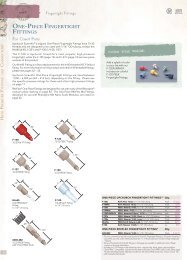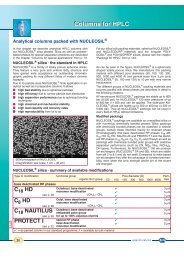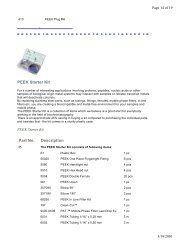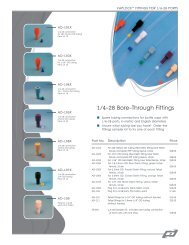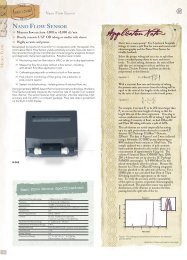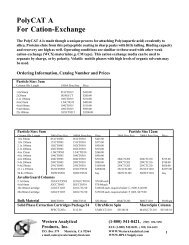Guide to Column Care and Use - The Nest Group
Guide to Column Care and Use - The Nest Group
Guide to Column Care and Use - The Nest Group
You also want an ePaper? Increase the reach of your titles
YUMPU automatically turns print PDFs into web optimized ePapers that Google loves.
Grace Vydac Product Focus<strong>Guide</strong> <strong>to</strong> <strong>Column</strong> <strong>Care</strong> <strong>and</strong> <strong>Use</strong><strong>The</strong> purpose of this guide is <strong>to</strong> provide information that will help you successfully use VYDAC ®HPLC columns. General instructions <strong>and</strong> specific column recommendations are described in thefollowing sections:Section 1Section 2Section 3Section 4General InstructionsProtein/Peptide Reversed-Phase <strong>Column</strong>s259VHP Polymer Reversed-Phase <strong>Column</strong>s201TP Specialty Reversed-Phase <strong>Column</strong>s <strong>and</strong> 302IC Ion <strong>Column</strong>sSECTION 1Starting <strong>to</strong> use your VYDAC HPLC columnRemove the plastic nuts at each end <strong>and</strong> connect the column <strong>to</strong> your HPLC system using low-deadvolumeValco-compatible male connec<strong>to</strong>rs. Two Valco nuts <strong>and</strong> ferrules are included with each column.<strong>Column</strong> protection<strong>Column</strong> lifetime can be extended by filtering all solvents <strong>and</strong> samples prior <strong>to</strong> use. We recommendusing a low-dead-volume in-line filter (available from Grace Vydac: Cat. No. CPF10, pkg of 10)between the injec<strong>to</strong>r <strong>and</strong> column <strong>to</strong> trap particles from solvents, pumps, the mixing chamber, <strong>and</strong> theinjec<strong>to</strong>r. We also recommend using a guard column if samples contain insoluble or strongly adsorbedmaterials that may clog the column. Cartridge-type guard columns are available for most VYDACHPLC columns. (See the enclosed High-Performance Guard <strong>Column</strong> product sheet).Pressure <strong>and</strong> temperature limitsVYDAC silica-based HPLC columns are stable from 0-60°C <strong>and</strong> at pressures up <strong>to</strong> 5000 psi(335 bar). <strong>The</strong> upper pressure limit of the HPLC system used should be set <strong>to</strong> a maximum of 5000 psi(335 bar).VYDAC 259VHP polymer reversed-phase columns are stable from 0-80°C, but pressure-limited<strong>to</strong> 3000 psi (200 bar). See specific information for 259VHP columns in Section 3.<strong>The</strong> back-pressure of VYDAC silica-based reversed-phase columns under st<strong>and</strong>ard test conditions(50-70% ace<strong>to</strong>nitrile in water) is initially in the range given below:<strong>Column</strong> Size Particle Diameter Flow Rate Back-Pressure Range2.1 x 250 mm 5 µm 0.20 mL/min 1000 - 2000 psi4.6 x 250 mm 5 µm 1.0 mL/min 1000 - 2000 psi4.6 x 150 mm 5 µm 1.0 mL/min 600 - 1400 psi10.0 x 250 mm 5 µm 5.0 mL/min 1000 - 2000 psi4.6 x 250 mm 10 µm 1.0 mL/min 500 - 1200 psi10.0 x 250 mm 10 µm 5.0 mL/min 500 - 1200 psi22.0 x 250 mm 10 µm 25.0 mL/min 500 - 1200 psiIf you have a problem with a VYDAC columnHPLC columns may become contaminated by strongly adsorbed sample constituents, causing anincrease in column back-pressure or loss of resolution. If a column appears <strong>to</strong> be contaminated:■ If the back-pressure is high, disconnect the column from the injec<strong>to</strong>r <strong>and</strong> run the pumps <strong>to</strong> ensurethat the back-pressure is due <strong>to</strong> the column <strong>and</strong> not the HPLC system.■ If the column back-pressure is high, the column may be reversed <strong>and</strong> rinsed <strong>to</strong> try <strong>to</strong> flush contaminantsfrom the inlet frit. Begin the reverse rinse at a low flow rate (0.5 mL/min for a 4.6 mm ID.column) for 10-15 minutes <strong>and</strong> then increase the flow <strong>to</strong> 1.5-2.0 mL/min (for a 4.6 mm ID. column;1.0-1.5 mL/min for polymer columns).■ Wash the column either with 10-20 column volumes of a strong eluent (high organic solvent forreverse phase columns; high salt for ion exchange columns) or run 2-3 “blank” (that is withoutsample injection) gradients as normally run <strong>to</strong> remove less strongly adsorbed contaminants.(continued on page 2)Grace Vydac is a business unit of W. R. Grace & Co.-Conn.
<strong>Guide</strong> <strong>to</strong> <strong>Column</strong> <strong>Care</strong> <strong>and</strong> <strong>Use</strong>■ If these steps do not res<strong>to</strong>re column performance, followthe recommendations for column regeneration found in thesection dealing with your specific column.■ If column performance is not res<strong>to</strong>red by any of these steps,please contact Grace Vydac in USA at (760) 244-6107 fortechnical assistance with the following information:✔ <strong>The</strong> type <strong>and</strong> lot number of the column. <strong>The</strong> lot number isthe series of numbers found at the <strong>to</strong>p center of the columnlabel (e.g. E980204-3-2) after the catalog number.✔ Describe the problem. If possible, send a FAX <strong>to</strong> USA(760) 244-1984 with a chroma<strong>to</strong>gram illustrating the problem.This will help in rapidly assessing <strong>and</strong> correcting the problem.SECTION 2VYDAC Protein/Peptide Reversed-Phase <strong>Column</strong>s:208, 214, 218, 219, <strong>and</strong> 238 TP <strong>and</strong> MSExcept for 238MS <strong>and</strong> 238TP, VYDAC silica-basedreversed-phase HPLC columns consist of hydrocarbon compoundschemically bonded <strong>to</strong> “TP” 300 angstrom pore-size silicathrough the use of multifunctional chlorosilanes. <strong>The</strong> resulting"polymeric" reversed phases are very resistant <strong>to</strong> hydrolysis.VYDAC 238MS <strong>and</strong> 238TP adsorbents are bonded usingmono-silane reagents, leading <strong>to</strong> a “monomeric” C18 phase.This produces subtle differences in selectivity which can beexploited <strong>to</strong> optimize peptide <strong>and</strong> protein separations. <strong>The</strong>238MS <strong>and</strong> 238TP adsorbents are exhaustively end-capped.Performance testingEach lot of reversed-phase material is tested for selectivitywith a set of peptides <strong>and</strong> a set of proteins. (219MS <strong>and</strong> 219TPare tested only with proteins, <strong>and</strong> 238MS <strong>and</strong> 238TP withpeptides). Each column is individually tested for packingefficiency using either biphenyl (for analytical columns) orbenzoate esters (for preparative scale columns). Test conditions<strong>and</strong> results are included with the column documentation.If you would like <strong>to</strong> test or verify column performance, werecommend repeating the selectivity <strong>and</strong>/or efficiency test.ShippingVYDAC Protein/Peptide Reversed-Phase columns areshipped in ACN:water (50:50 for C4 <strong>and</strong> diphenyl, 60:40for C8 <strong>and</strong> C18 adsorbents). Preparative columns are shippedin methanol:water.<strong>Column</strong> ConditioningBecause of the nature of the reversed-phase surface, columnperformance (resolution, retention) may change slightly duringthe first few injections of polypeptide. "<strong>Column</strong> conditioning"occurs for most polypeptides larger than 10,000 MW. A columncan be conditioned by repeated injections of a polypeptide untilthe column characteristics remain constant (typically requiresinjection of about 100 µg of polypeptide on a 4.6 mm ID x250 mm column) or by injection of 100 µg of a commonlyavailable protein such as ribonuclease, followed by elution of thecolumn with a typical ace<strong>to</strong>nitrile gradient with 0.1% TFA.<strong>Column</strong> s<strong>to</strong>rageVYDAC Protein/Peptide Reversed-Phase columns maybe s<strong>to</strong>red in any combination of organic solvent <strong>and</strong> water. Forlong term s<strong>to</strong>rage ion-pair reagent should be flushed from thecolumn <strong>and</strong> the organic content should be at least 50%. <strong>The</strong>column should be sealed with the plastic plugs originallysupplied.Chemical StabilityVYDAC Reversed-Phase Protein/Peptide columns are stablein most common organic solvents including ace<strong>to</strong>nitrile, methanol,ethanol, isopropanol, dichloromethane <strong>and</strong> chloroform. Whenswitching solvents it is important <strong>to</strong> verify that subsequentsolvents are miscible with the previous solvent used. Protein/Peptide columns are very resistant <strong>to</strong> hydrolysis, can be usedwith eluents as low as pH 2 (such as 0.1% trifluoroacetic acid)for long periods of time, <strong>and</strong> are stable <strong>to</strong> occasional useat lower pH if columns are s<strong>to</strong>red at pH higher than 2. SilicabasedProtein/Peptide Reversed-Phase columns should not beused above pH 7. USE ABOVE pH 7 IS LIKELY TO RE-DUCE THE COLUMN LIFETIME!We suggest using a polymer reversed-phase column(VYDAC 259VHP, Section 3) under basic elution conditions.Common protein detergents such as sodium dodecylsulfate(SDS) can be used without harm <strong>to</strong> columns <strong>and</strong> may beremoved by rinsing the column with ace<strong>to</strong>nitrile or isopropanol.However, detergents are likely <strong>to</strong> affect the resolution of thecolumn during the run in which they are present.Oxidative eluents or sample additives should be avoided.Recommended elution conditionsVYDAC Protein/Peptide Reversed-Phase columns aretypically eluted with an increasing gradient of organicsolvent in the presence of an ion-pairing agent. <strong>The</strong> mostcommon organic solvent used is ace<strong>to</strong>nitrile due <strong>to</strong> its lowviscosity, good UV transparency <strong>and</strong> high volatility. Ethanol orisopropanol are also occasionally used. Trifluoroacetic acid(TFA) is the most commonly used ion-pair reagent <strong>and</strong> isusually present at concentrations of 0.05 - 0.2% (w/v).However, VYDAC LC/MS grade columns (208MS, 214MS,218MS, 219MS, 238MS) produce excellent separations with TFAconcentrations as low as 0.01% (w/v) or no TFA <strong>and</strong> one of thefollowing ion-pairing reagents: acetic acid, formic acid, heptafluorobutyricacid (for basic polypeptides), triethylamine phosphate(TEAP), phosphoric acid.Typical flow rates for VYDAC Protein/Peptide Reversed-Phase columns are:Capillary 75 µm diameter 0.25 µL/min100 µm diameter 1 µL/min300 µm diameter 5 µL/min500 µm diameter 10 µL/minMicrobore 1.0 mm diameter 25-50 µL/minNarrow Bore 2.1 mm diameter 100-300 µL/minAnalytical 4.6 mm diameter 0.5-1.5 mL/minSemipreparative 10.0 mm diameter 2.5-7.5 mL/minPreparative 22 mm diameter 10-30 mL/minProcess 50 mm diameter 50-100 mL/min100 mm diameter 150-300 mL/min2
<strong>Guide</strong> <strong>to</strong> <strong>Column</strong> <strong>Care</strong> <strong>and</strong> <strong>Use</strong><strong>Column</strong> cleaning <strong>and</strong> regenerationVYDAC Protein/Peptide Reversed-Phase HPLC columns maybecome contaminated by strongly adsorbed sample constituentscausing a loss in column performance. If the recommendationsgiven on page 1 fail <strong>to</strong> correct the problem:■ Inject 500 µL of 1% SDS solution at 1 mL/min (for 4.6 mmID column). <strong>The</strong>n run a 10-minute gradient from 5% <strong>to</strong> 95%ACN with 0.1% (v/v) TFA.■ If lipids or very hydrophobic small molecules are causing thechange in column performance, we recommend rinsing thecolumn with several column volumes of dichloromethane orchloroform. When changing from water <strong>to</strong> chloroform ordichloromethane or back again it is important <strong>to</strong> rinse thecolumn with a mutually miscible, intermediate solvent such asisopropanol or ace<strong>to</strong>ne between the two less miscible solvents.■ If the loss in column performance appears <strong>to</strong> be due <strong>to</strong> adsorbedprotein we recommend rinsing any of the polymeric-bondedcolumns with a mixture of one part 0.1 N nitric acid <strong>and</strong> fourparts isopropanol. Rinsing at a low flow rate (20% of normal)overnight is most effective. NOTE: WASHING WITH NITRICACID IS NOT RECOMMENDED FOR 238MS AND 238TP“MONOMERIC” REVERSED-PHASE COLUMNS.SECTION 3VYDAC 259VHP Polymer Reverse-Phase <strong>Column</strong>sVYDAC 259VHP reversed-phase columns contain highlycross-linked polystyrene-divinylbenzene copolymer beads with300 Å pores. A proprietary surface modification enhancesseparation performance. 259VHP columns are designed forseparation of proteins <strong>and</strong> peptides, but can also be used forseparating small molecules. <strong>The</strong>y are stable from 1 N acid <strong>to</strong> 1N base at ambient temperature. This provides a broad choiceof mobile phases, including conditions of pH where silica-basedreversed-phase columns can not be used. 259VHP columns arecompatible with most common organic solvents.Performance testingEvery lot of 259VHP material is tested for selectivity usingprotein <strong>and</strong> peptide st<strong>and</strong>ards.Shipping <strong>and</strong> first use259VHP columns are shipped in 50:50 ace<strong>to</strong>nitrile:water.Prior <strong>to</strong> use, we recommend rinsing with 10 column volumes(25 mL for a 259VHP5415 column) of the weak mobile phase(solvent A) followed by a blank gradient from 0 <strong>to</strong> 100% B.Pressure limit259VHP columns are stable <strong>to</strong> 3000 psi (200 bar). <strong>The</strong>upper pressure limit of your HPLC system should be set atless than 3000 psi (200 bar). For best column lifetime, a flowrate of 1.0 mL/min or lower is recommended for 259VHP5415(4.6 mm ID X 15 cm). For columns with other dimensions, theflow rate can be adjusted accordingly.Chemical <strong>and</strong> temperature stabilityVYDAC 259VHP columns are stable from pH 1 <strong>to</strong> pH 14 <strong>and</strong>temperatures from 0 <strong>to</strong> 80°C. However, strong-acid <strong>and</strong> strongbasecleaning should NOT be done at elevated temperatures.<strong>Column</strong> cleaning <strong>and</strong> regenerationStrongly adsorbed proteins <strong>and</strong> other contaminants that arenot removed by normal gradients can lead <strong>to</strong> loss of columnperformance. Should this occur, 259VHP columns can often becleaned by spot injections of common denaturants.All denaturant solutions should be membrane filteredimmediately before use <strong>to</strong> remove particles greater than 0.5 µm.Syringe filters are convenient for small volumes. For strong base(1 N NaOH), be sure the polyimide injec<strong>to</strong>r ro<strong>to</strong>r is replacedwith a base-resistant material <strong>and</strong> use a PTFE membranefilter <strong>to</strong> remove particulates.All procedures should be performed at room temperatureunless otherwise noted.Connect the column in reverse-flow direction. Program theHPLC system <strong>to</strong> run 10 minute gradients from 0 <strong>to</strong> 100% B atflow rate 1.0 mL/min (for 4.6 mm ID column) with A = 0.1%TFA (v/v) in 10:90 ACN/water, <strong>and</strong> B = 0.1% TFA (v/v) in90:10 ACN/water. Moni<strong>to</strong>r absorbance continuously at 280 nm.For each procedure, inject the denaturant in solvent A then runthe gradient. Repeat the procedure several times until thebaseline profile remains constant from run <strong>to</strong> run, indicatingabsence of further desorption.Depending on the contaminants, one or more denaturantsmay be effective. Amounts per injection are for 4.6 mm IDcolumn.1) 1% or 2% SDS in 10:90 ACN/water. Inject 500 µL.2) 50:50 IPA:6 M guanidine HCl. Inject 200 µL at 0.2 mL/min.(This solution is very viscous, necessitating the low flow rate.Also, it is very important <strong>to</strong> filter the guanidine HCl solutiontwo or three times, before <strong>and</strong> after adding IPA, in order <strong>to</strong>avoid introducing particles that can clog the column.)3) Any of the following at low flow (0.2 mL/min):✔ 100% TFA. Inject 200 µL.✔ Glacial acetic acid. Inject 1 mL.✔ Formic acid. Inject 1 mL.✔ 1M phosphoric acid. Inject 1 mL.Repeat step 2. Steps 1 through 3 are strongly solubilizing forproteins <strong>and</strong> lipids.4) 1 N NaOH. Inject 2-3 mL at 0.2 mL/min. (Base hydrolysis ofproteins <strong>and</strong> peptides breaks them in<strong>to</strong> smaller units withgreater solubility.)Test column performance under normal gradient conditionswhen the 280 nm trace indicates that the column is clean.Other procedures <strong>to</strong> try:■ Using your normal mobile phase buffer, heat the column <strong>to</strong>60°C <strong>and</strong> run a 0 <strong>to</strong> 100% ACN gradient several times.■ Repeat steps 1 through 4 using IPA (a stronger solvent) inplace of ACN in the mobile phase. <strong>Use</strong> a lower flow rate (0.5mL/min suggested) <strong>to</strong> allow for the higher viscosity of thismobile phase.■ If these steps do not appear <strong>to</strong> remove all lipids or other nonpolarcontaminants, the column can be cleaned by rinsingwith chloroform or dichloromethane, as described in Section 3for silica-based protein-peptide reversed phase columns, beingsure <strong>to</strong> proceed from water through intermediate rinses withmutually miscible solvents such as isopropanol or ace<strong>to</strong>ne.3
<strong>Guide</strong> <strong>to</strong> <strong>Column</strong> <strong>Care</strong> <strong>and</strong> <strong>Use</strong>SECTION 4VYDAC 201TP Specialty Reversed-Phase<strong>Column</strong>sVYDAC 201TP reversed-phase HPLC columns consist ofC 18hydrocarbon chains bonded <strong>to</strong> TP (300 angstrom) silicausing multifunctional silanes which result in a "polymeric"cross-linked reverse-phase. 201TP adsorbents are not end-capped.Performance testingEvery lot of 201TP reversed-phase material is tested forselectivity using the sixteen EPA priority-pollutant polyaromatichydrocarbons.ShippingVYDAC 201TP reversed-phase columns are shipped in60:40 ace<strong>to</strong>nitrile:water.Recommended elution conditionsElution conditions for 201TP reversed-phase columns are asspecified by EPA when used for analysis of priority pollutantPAHs.Common recommendationsAside from items noted above, information <strong>and</strong> recommendationsare as offered in Section 2 for VYDAC Protein/PeptideReversed-Phase columns.VYDAC 302IC Ion <strong>Column</strong>sVYDAC 302IC ion-chroma<strong>to</strong>graphy columns contain alow-capacity anion-exchange (quaternary amine) materialbased on high-purity large-pore silica. <strong>The</strong>y can be used withordinary HPLC systems for analysis of common anions <strong>and</strong>organic acids.Performance testingEvery lot <strong>and</strong> each column of 302IC ion-chroma<strong>to</strong>graphymaterial is tested for selectivity <strong>and</strong> efficiency.Results from the selectivity/efficiency test are enclosedwith the column documentation. If you would like <strong>to</strong> test orverify column performance we recommend repeating theselectivity/efficiency test.Copyright © 2002. W. R. Grace & Co.-Conn. All rights reserved. VYDAC is a trademark of<strong>The</strong> Separations <strong>Group</strong>, a wholly-owned subsidiary of W. R. Grace & Co.-Conn.Prices <strong>and</strong> specifications subject <strong>to</strong> change without notice.ShippingVydac 302IC columns are shipped in 50:50 methanol:water.<strong>Column</strong> s<strong>to</strong>rageVYDAC 302IC columns may be s<strong>to</strong>red in any combinationof organic solvent <strong>and</strong> water after first rinsing the column free ofsalts, buffers or acids. For long term s<strong>to</strong>rage the organic contentshould be at least 50%.Chemical StabilityVYDAC 302IC columns are stable in common organicsolvents such as ace<strong>to</strong>nitrile, methanol, isopropanol <strong>and</strong> dichloromethane.When switching solvents it is important <strong>to</strong> verify thatsubsequent solvents are miscible with the previous solventused. <strong>The</strong> recommended pH range for 302IC columns is pH 2 - 6.5.THE USE OF 302IC COLUMNS ABOVE pH 6.5 WILLREDUCE THE COLUMN LIFETIME.Recommended elution conditionsVYDAC 302IC columns are eluted with buffered aqueouseluents. <strong>The</strong> conditions shown on the selectivity test chroma<strong>to</strong>gramare the best starting point for developing a new separation. <strong>The</strong>recommended flow rate is that used in the original column test,although somewhat lower flow rates may be effectively used.<strong>Column</strong> cleaning <strong>and</strong> regenerationVYDAC 302IC columns may become contaminated bystrongly adsorbed sample constituents, causing a loss of columnperformance. If the recommendations on page 1 do not res<strong>to</strong>reperformance, 302IC columns can often be regenerated by rinsingthe column with strong buffer (2-3 X the strength of the buffernormally used). <strong>Column</strong>s can also be rinsed with 0.05M EDTA<strong>to</strong> remove adsorbed anions or with 0.05M nitric acid <strong>to</strong> removeadsorbed cations. To remove adsorbed hydrophobic molecules,rinse the column with several column volumes of dichloromethaneor chloroform. When changing from water <strong>to</strong> chloroform ordichloromethane or back again it is important <strong>to</strong> rinse thecolumn with a mutually miscible intermediate solvent such asisopropanol or ace<strong>to</strong>ne between the two less miscible solvents.If you need additional information or have questionsnot answered in this guide, please contact Grace Vydacvia phone, FAX, or email as indicated below <strong>and</strong> askfor technical assistance.Or visit Grace Vydac’s online FAQ page atwww.gracevydac.com4GRACE VYDAC • 17434 Mojave Street • Hesperia, CA 92345 • USAToll-Free: 800-247-0924 • Tel: 760-244-6107 • Fax: 760-244-1984Web: www.gracevydac.com • EMail: experts@vydac.com







